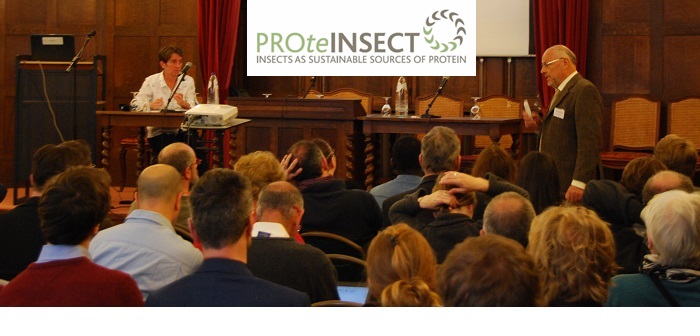The message from the animal feed industry concerning the future inclusion of insect protein in pig, poultry and fish diets is “we are ready” delegates at yesterday’s PROteINSECT conference in Brussels were told by the man who analysed the feeding trials for each species.
“I attended the global feed industry congress in Turkey last week and whenever I mentioned insect protein the response amounted to just three words ‘we are ready’,” said Dr Geert Bruggeman of Belgian-based Nutrition Sciences, commenting after presenting a positive set of feed trials results to the Brussels gathering.

He then warned delegates, however, that moving from today’s encouraging trials platform to being able to use insect protein commercially would involve overcoming two major “bottlenecks”.
“The first is legislation and the second is production scale,” he said. “Until the correct legislation is in place to allow insect protein to be used in feeds, we can’t move forward.”
According to his trials’ analysis of insect protein in terms of performance, health and taste, however, he was entirely positive, a position backed by Fera Science’s Dr Adrian Charlton, who told delegates were an “innovative new source of feed” and a “viable option” for farmers to consider.
“Insects are already a natural component of the diet of poultry, pigs and fish in free-range systems and in the wild, so it is logical to investigate the options of feeding insects commercially to these species,” said Dr Charlton.
“While there is a lot of work to do to understand and manage safety risks for animal feed, the early indications are very promising. In terms of a protein source, in fact, insect protein is around 86-89% digestible; significantly higher than most vegetable based protein. There is also the potential for high value by-products such as fats and oils.
“That, combined with potential production efficiencies, makes insect feed attractive for the future of animal nutrition. So, for example, soya yields around 0.9t protein/ha, compared to insects that potentially yield 150t/ha protein. That offers the potential of a 200-fold reduction in land use.
“Although we obviously need to understand the methods of production, the costs of production and the safety elements, the early data suggests this is a viable option for the future.”
As for how soon insect protein might actually become available for commercial use, Pig World questioned PROteINSECT’s coordinator, Dr Elaine Fitches, seeking her own “best case scenario”.
“I was encouraged by the input into our conference by the European Commission’s Dr Wolfgang Truck, and the timeline indications he’s now giving us for moving the legislation forward. It has taken a long time to gather the momentum we’re now experiencing, particularly in getting all the member states on board with what we’re doing.
“In the context of what we’ve heard today (April 27), therefore, I would hope that within the next five years the legislation will be in place to enable people to use insect protein (for the species being trialled) and that the production of insect protein will then become a confirmed and consolidated industry.”
Headline image shows FAO advisor, Paul Vantomme, addressing the Brussels conference with Dr Elaine Fitches on the conference platform (back left)




